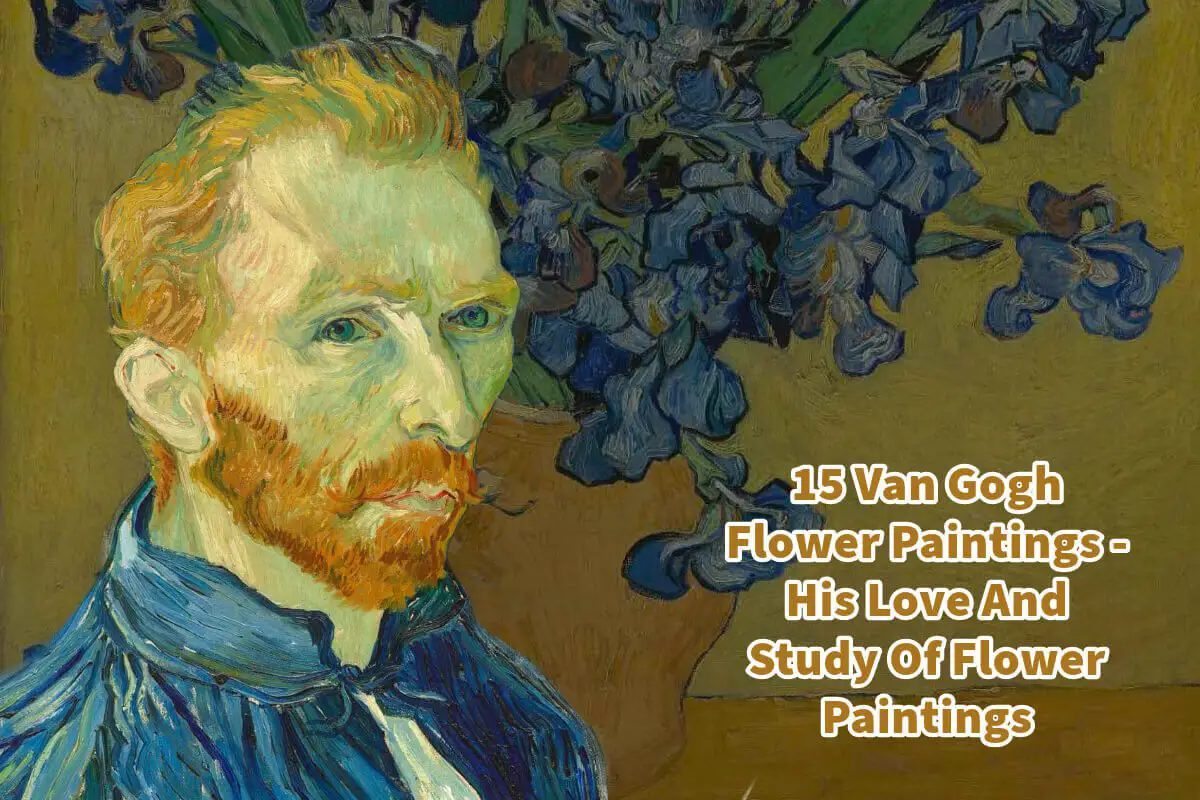Flowers held a special place in Vincent van Gogh’s artistic repertoire. The celebrated artist had an enduring passion for depicting blooms, and some of these works are among my all-time favorites of his entire oeuvre.
With their vibrant color palettes and intricate shapes, flowers were an ideal subject for Van Gogh to channel his love for nature’s beauty and experiment with color theory. Read on as we will explore the reasons behind Van Gogh’s fascination with floral themes and examine some of his most significant flower paintings.
Table of Contents
- Vincent Van Gogh’s Love And Study Of Flowers In His Paintings
- 15 Vincent Van Gogh Flower Paintings
- Sunflowers
- Vase With Fifteen Sunflowers
- Irises
- A Vase With Twelve Sunflowers
- Almond Blossoms
- Poppy Flowers
- Vase With Poppies
- Imperial Fritillaries in a Copper Vase
- Four Withered Sunflowers
- Vase With Three Sunflowers
- Vase With Irises Against a Yellow Background
- View of Arles with Irises in the Foreground
- Blossoming Chestnut Branches
- Two Cut Sunflowers
- Vase with Five Sunflowers
- Frequently Asked Questions
- Related Questions
Vincent Van Gogh’s Love And Study Of Flowers In His Paintings
The canvas of history is painted with the unique colors of Vincent Van Gogh, an artist whose work was not just a feast for the eyes but also an exploration of the psyche. Among the sunsets and starry nights, one subject matter that captivated Van Gogh’s attention was flowers.
Their vivid hues and diverse shapes offered him the perfect ground to express his love for natural beauty and study color. We will explore why Van Gogh was fascinated by flowers and some of his top paintings.
Van Gogh’s Affinity For Flowers
Why did Van Gogh paint flowers so frequently? This question has multiple layers, much like the textured brush strokes on his canvas.
On a basic level, flowers were conveniently available subjects; they were less challenging to paint than complex landscapes or human models.
On a deeper level, Van Gogh found an emotional refuge in painting flowers. They allowed him to hone his skills with color theory—exploring the dynamics of hue, value, and saturation—without being constrained by the rigid forms of other subjects.
But perhaps the most poignant reason lies in the personal symbolism flowers held for him. Van Gogh once said, “The sunflower is mine, in a way.” For him, flowers were beautiful symbols of emotions, life cycles, and the universe.
15 Vincent Van Gogh Flower Paintings
Van Gogh painted and loved flowers. He loved to use them to study color and paint them in various settings. Here are 15 of his top flower paintings.
Sunflowers
Vincent van Gogh, 1889

This is perhaps the most iconic of Van Gogh’s flower paintings. It is a vibrant work characterized by its brilliant yellow hues. Van Gogh created several versions of “Sunflowers,” each a testament to his mastery of color and emotional connection to the subject.
This painting is often viewed as an emblem of happiness and optimism, though for some, it also contains undertones of the loneliness and introspection that often plagued the artist.
Vase With Fifteen Sunflowers
Vincent van Gogh, 1888

Another beautiful painting in the “Sunflowers” series, this painting showcases fifteen sunflowers in a simple earthen vase. The unique arrangement allows viewers to see the flowers from various angles, creating a sense of depth and perspective.
The choice of a vibrant yellow background amplifies the warmth, making it a groundbreaking piece in using color to evoke emotion.
Irises
Vincent van Gogh, 1889
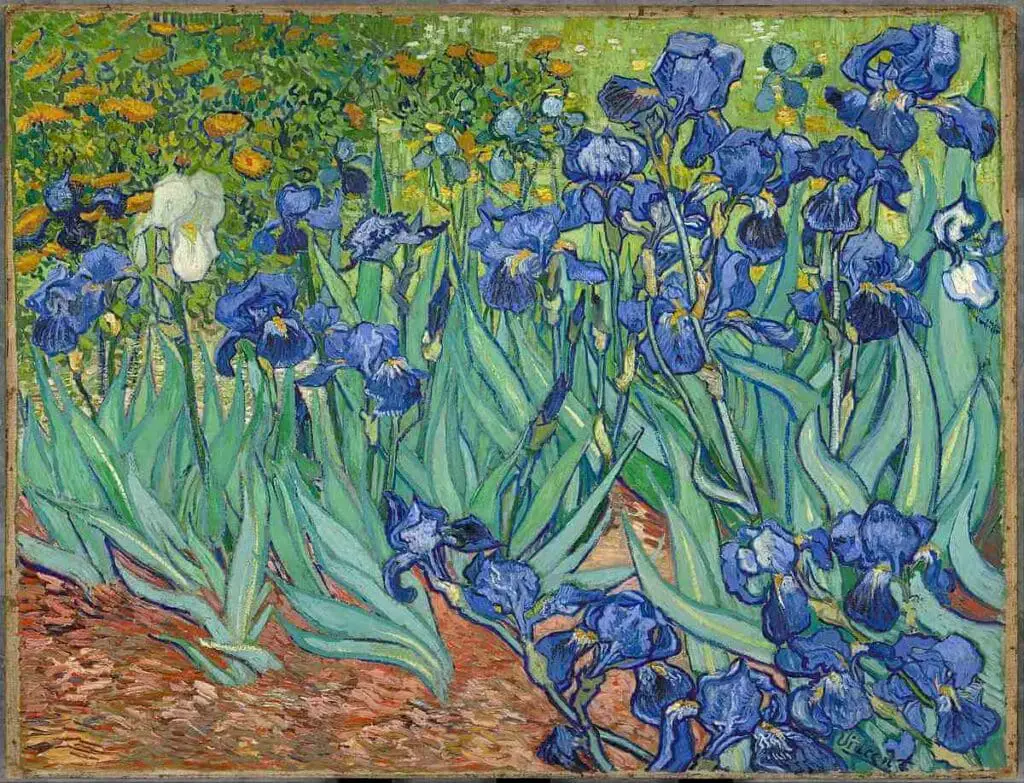
“Irises” was painted while Van Gogh was in an asylum in Saint-Rémy. Though created during a turbulent time, the painting is imbued with energy and life. The undulating forms of the irises, set against a contrasting background, exemplify the artist’s fascination with color and form.
The painting often represents the turmoil and vitality coexisting within him.
A Vase With Twelve Sunflowers
Vincent van Gogh, 1888

This painting is yet another masterpiece from his Arles period, featuring twelve sunflowers in various stages of bloom. Van Gogh’s mastery in depicting light and shadow on the petals and vases adds a tactile richness to the work.
The blue background helps the yellow flowers’ pop,’ illustrating his in-depth understanding of complementary colors.
Almond Blossoms
Vincent van Gogh, 1890
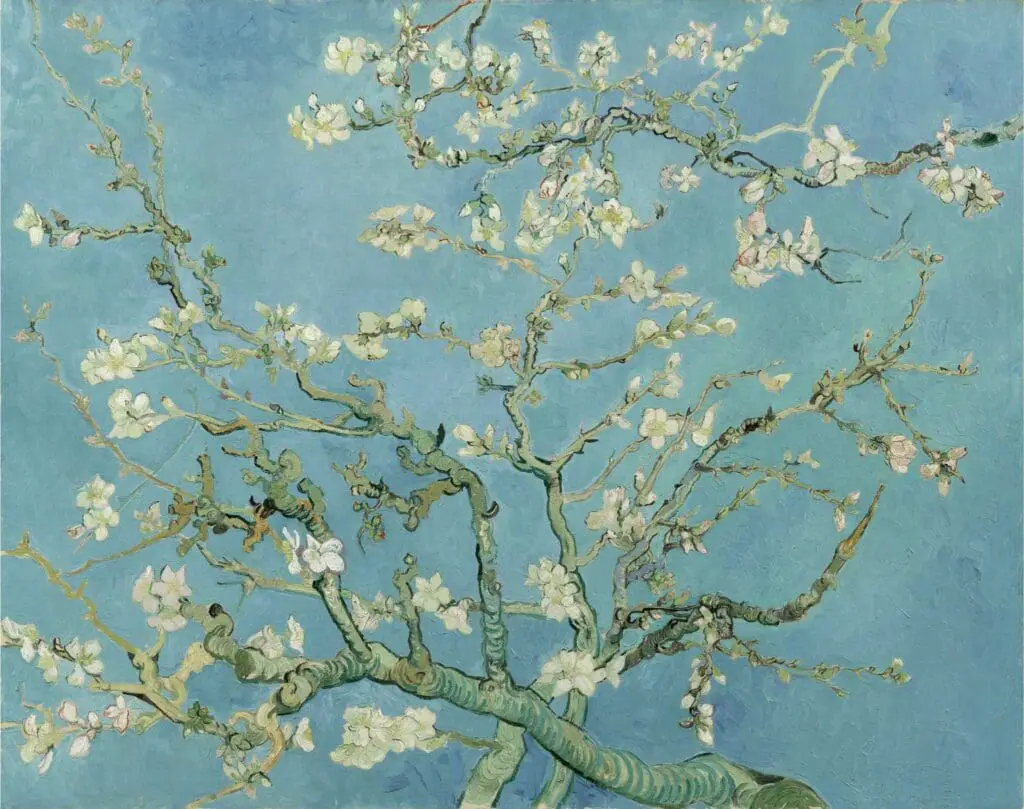
Created for his newborn nephew, “Almond Blossoms” represents new beginnings. The painting diverges from his typical palette, dominated by a bright sky-blue background against which the white blossoms appear ethereal.
This piece can be viewed as one of his most optimistic, reflecting hope amidst personal struggles.
The Almond Blossoms is probably one of my favorite Van Gogh flower paintings. In these paintings, you can see Van Gogh’s influence on the Japanese Ukiyo-E Woodblock print artists.
Poppy Flowers
Vincent van Gogh, 1887
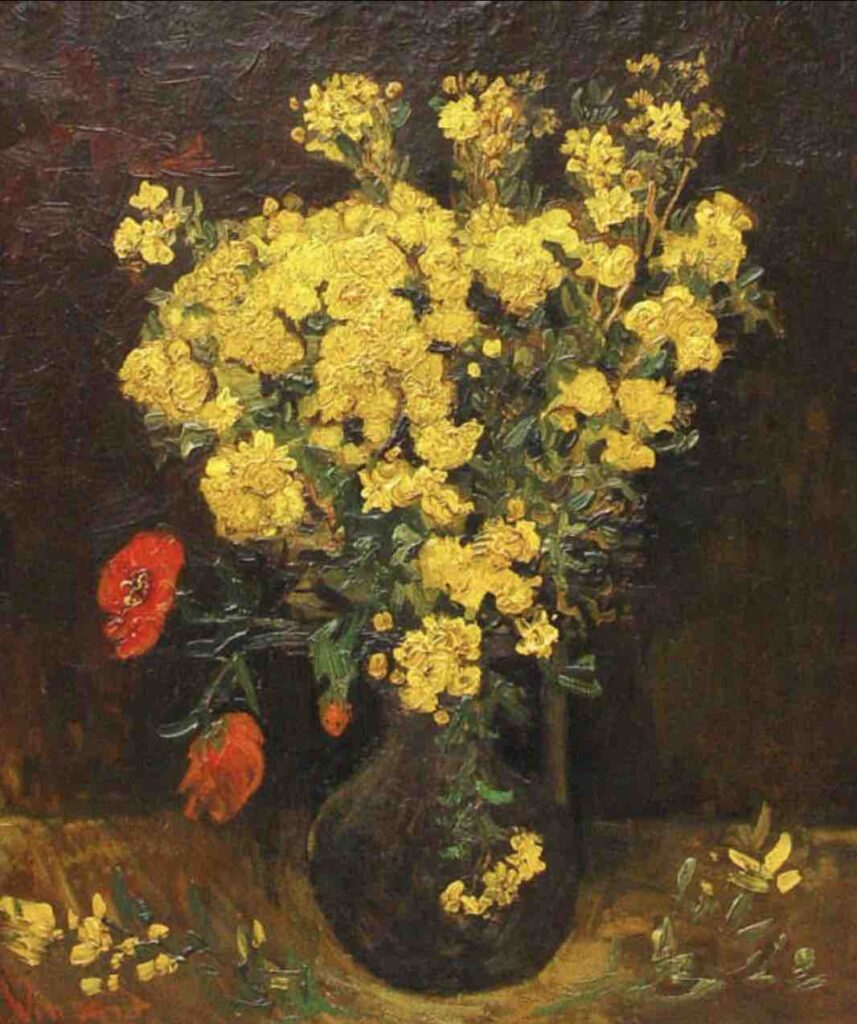
This painting features vivid red and yellow poppies against a dark background. Van Gogh’s bold use of contrasting colors exemplifies his experimental approach to color theory. The painting is also significant for its potential symbolism, as poppies are often associated with sleep and death, echoing the darker facets of his life.
Vase With Poppies
Vincent van Gogh, 1886
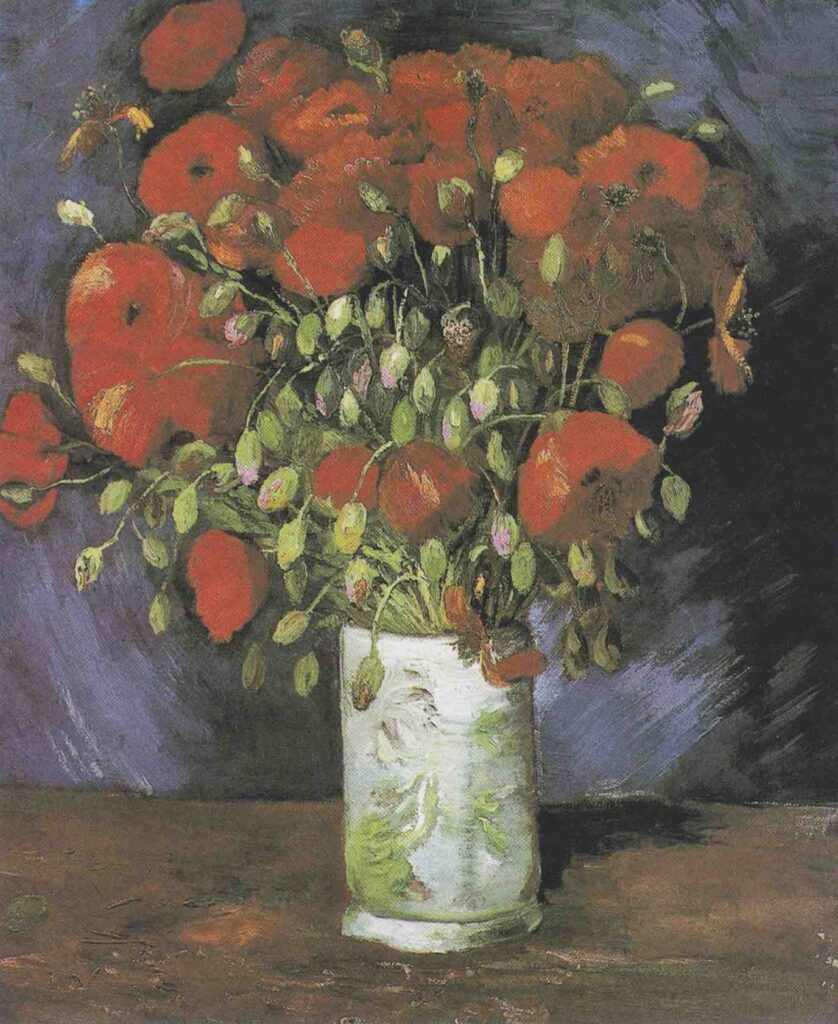
Featuring poppies in a vase, the composition and color palette are more straightforward but still evocative. The reds and greens create a lively contrast, capturing the essence of the poppies while providing a rich aesthetic experience for the viewer.
Imperial Fritillaries in a Copper Vase
Vincent van Gogh, 1887
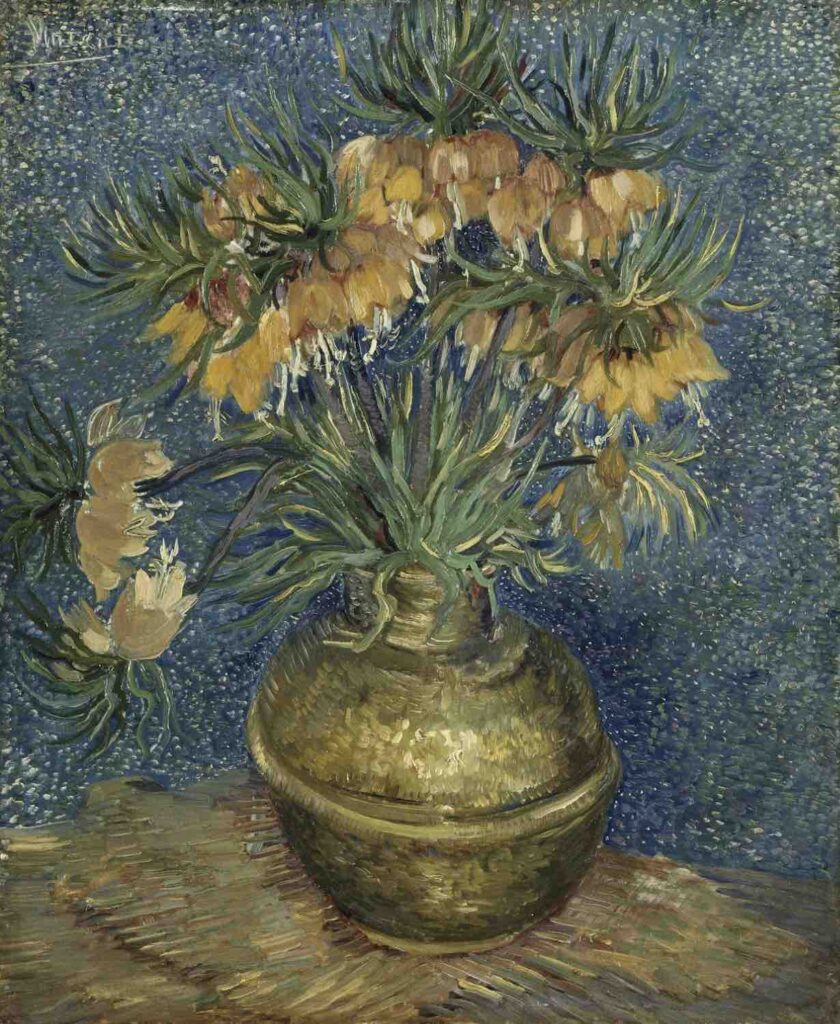
This painting is a masterpiece of texture and color. The rounded shape of the fritillaries, captured in orange and yellow hues, is magnificently contrasted by the reflective copper vase.
The painting perfectly exemplifies how Van Gogh used flowers to experiment with texture and materiality.
Four Withered Sunflowers
Vincent van Gogh, 1887
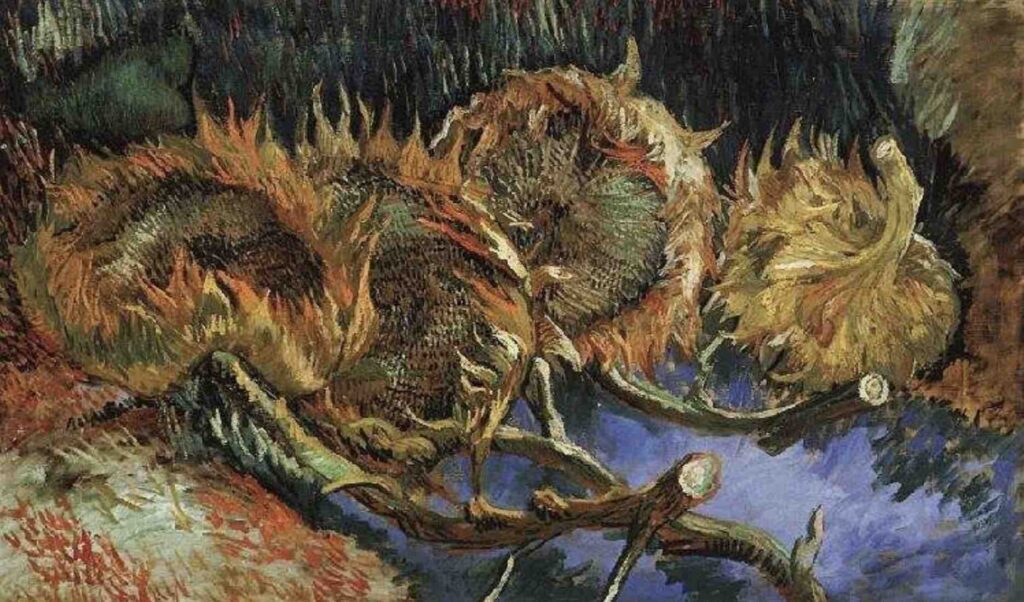
Depicting sunflowers in their final stages of life, this painting is a departure from his more vibrant floral works. It’s a symbolic reflection on mortality, capturing the beauty even in decay.
Vase With Three Sunflowers
Vincent van Gogh, 1888

Like other works in the “Sunflowers” series, this painting features three sunflowers in different stages of life. The use of contrasting colors and varied brush strokes make it a study of texture and emotion rendered through floral simplicity.
Vase With Irises Against a Yellow Background
Vincent van Gogh, 1889
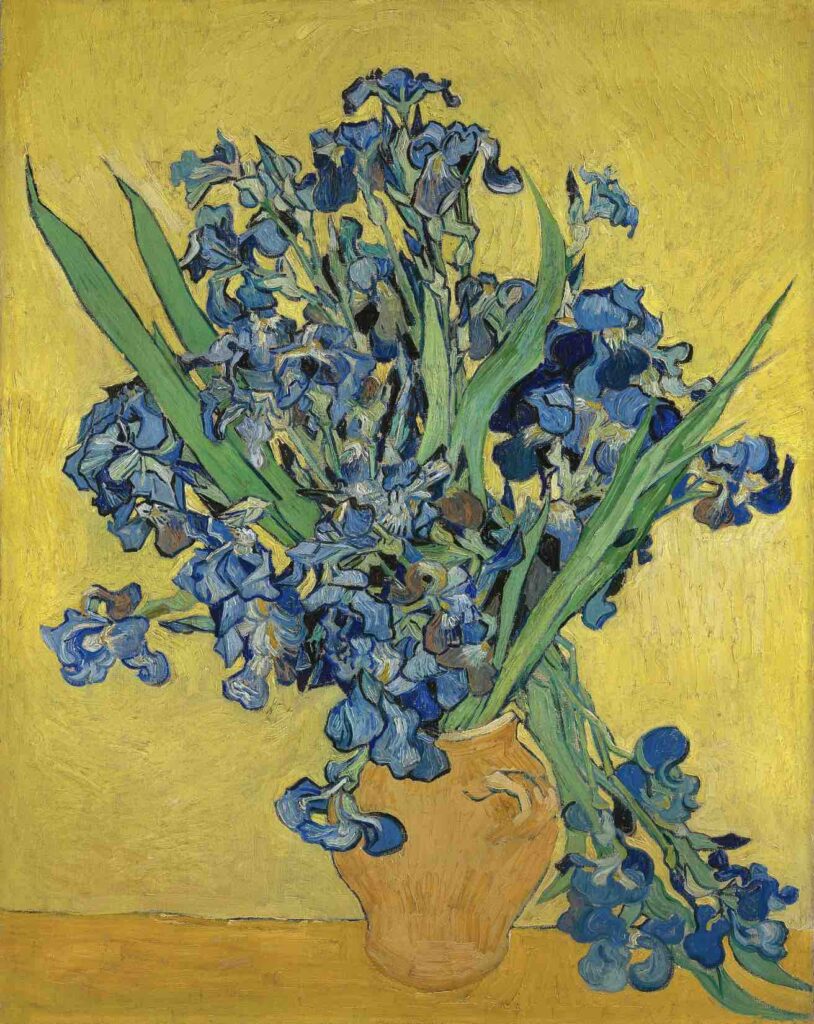
A variant of the “Irises” painting, this piece is set against a yellow background. The striking color contrast intensifies the emotional resonance of the painting, making it an essential part of his floral portfolio.
View of Arles with Irises in the Foreground
Vincent van Gogh, 1888
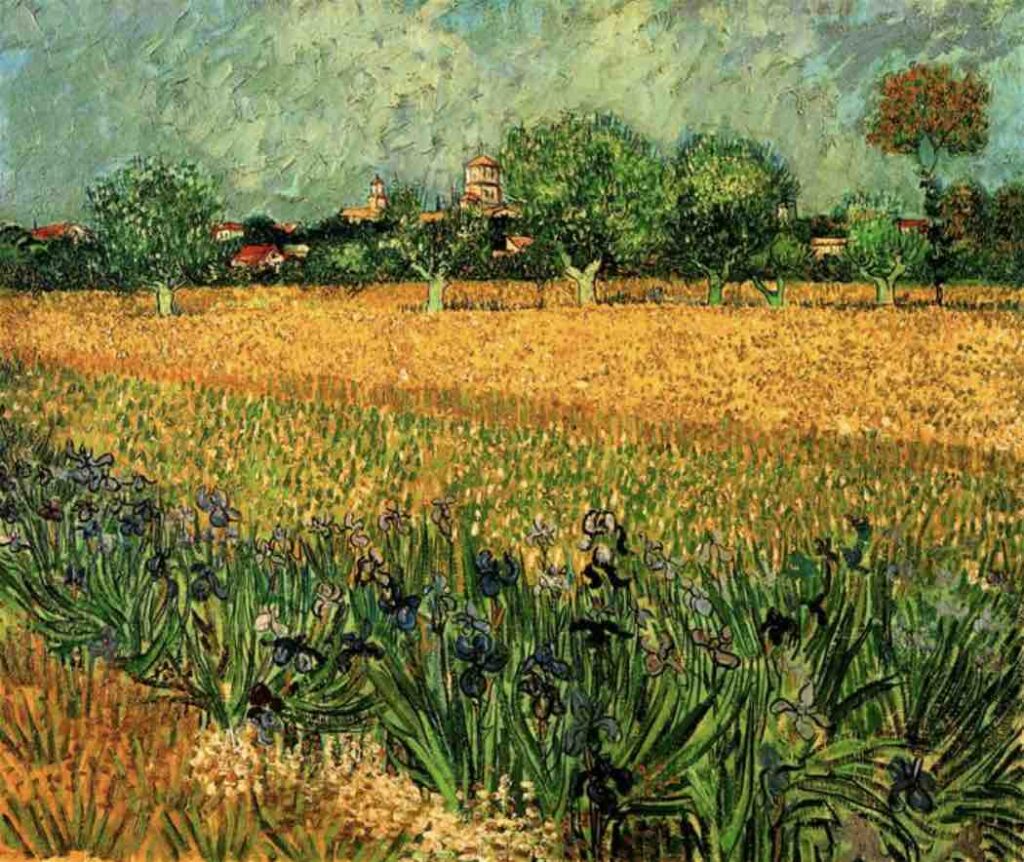
This painting uniquely combines his love for landscapes with his affinity for flowers. The irises in the foreground serve as a visual entry point into the idyllic landscape of Arles, symbolizing his emotional connection to the locale.
Blossoming Chestnut Branches
Vincent van Gogh, 1890
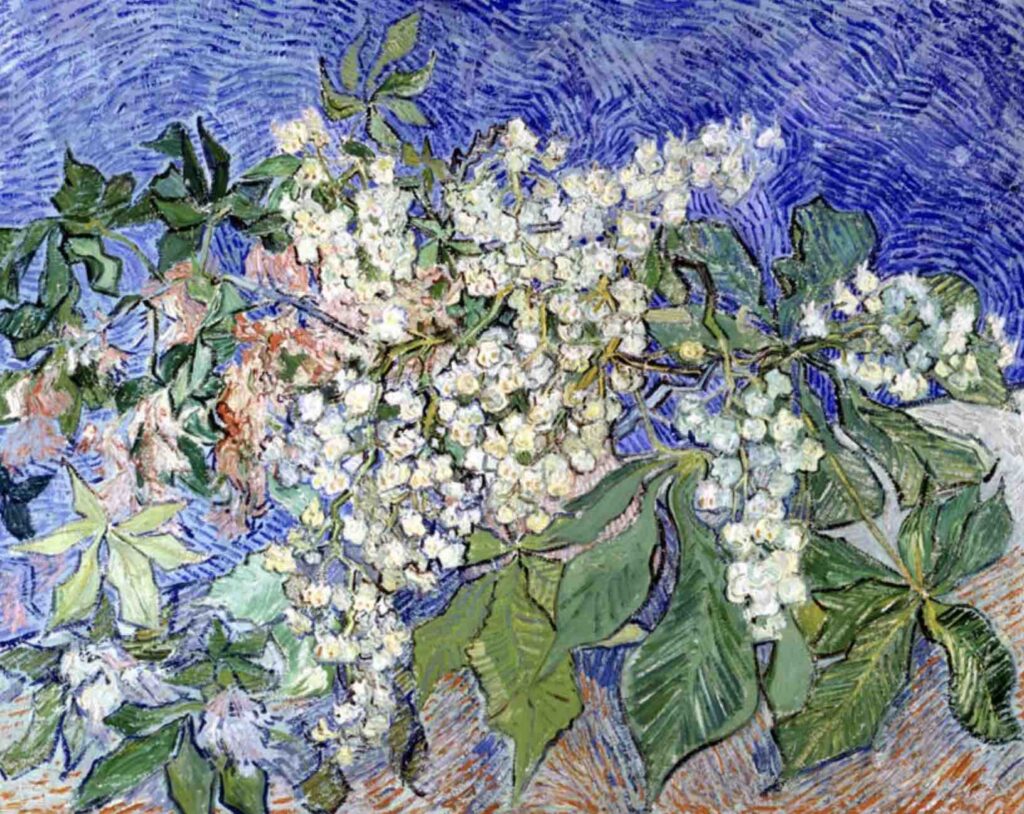
Featuring chestnut branches in full bloom, the painting is noted for its intricate detail and refreshing color palette. It encapsulates the transient beauty of spring, serving as a visual metaphor for cycles of life and rebirth.
Two Cut Sunflowers
Vincent van Gogh, 1887
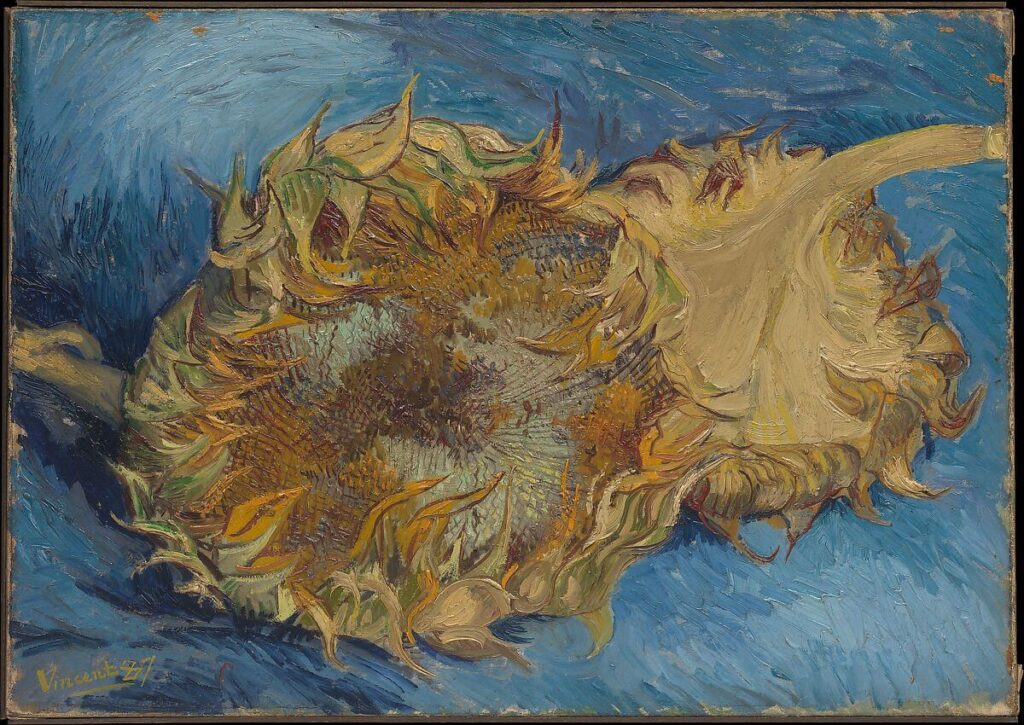
This painting features two flat-cut sunflowers, contrasting his more vibrant, upright sunflower works. The melancholy tone is evident, yet there is beauty in its serenity.
Vase with Five Sunflowers
Vincent van Gogh, 1888

Featuring five sunflowers, the painting explores varying shades of yellow, from the golden petals to the darker, shadowy crevices. It reflects Van Gogh’s continual experimentation with the emotional potency of color.
Vincent Van Gogh’s floral works are not just beautiful; they are a deep dive into the artist’s mind, his experiments with color, and his relationship with the natural world. They remain timeless pieces, each one a petal in the complex bouquet that is Van Gogh’s artistic legacy.
Frequently Asked Questions
Did Paul Cézanne and Vincent van Gogh ever meet in person?
While both artists were active during the same period, there is no documented evidence that suggests they met face-to-face. They moved in different artistic circles.
How did Paul Cézanne and Vincent van Gogh influence each other’s art?
Although there is no direct evidence of mutual influence, art historians speculate that both artists may have indirectly influenced each other through their innovative approaches to color, form, and expression.
Were Paul Cézanne and Vincent van Gogh friends or rivals?
There is no evidence of a personal relationship between the two artists. They were pursuing their own artistic visions and were not known to be either friends or rivals.
What were the major themes in Paul Cézanne’s artwork?
Cézanne was known for his exploration of still life, landscapes, and the human figure. His emphasis on geometric shapes and the use of color paved the way for later artistic movements.
How did Vincent van Gogh’s mental health impact his art, and did Cézanne face similar challenges?
Van Gogh’s mental health struggles are well-documented and influenced his expressive and emotionally charged artworks. Cézanne, on the other hand, did not face similar mental health challenges and focused more on formal aspects of art.
What artistic techniques did Vincent van Gogh employ that differed from Paul Cézanne?
Van Gogh was known for his bold use of color, dynamic brushstrokes, and emotionally charged compositions. Cézanne, in contrast, focused on the structural aspects of form and often used repetitive brushstrokes to build up his paintings.
Did Paul Cézanne and Vincent van Gogh share any common artistic influences?
Both artists were influenced by the Impressionist movement, although they took different paths in their artistic development. Cézanne also drew inspiration from classical art, while Van Gogh was influenced by Japanese prints and the art of the Far East.
How did critics and the art world perceive Paul Cézanne and Vincent van Gogh during their lifetimes?
Cézanne faced initial resistance from traditional art circles, while Van Gogh’s work was often misunderstood and underappreciated during his lifetime. However, both artists gained recognition posthumously as their contributions to art became more widely acknowledged.
Did Paul Cézanne and Vincent van Gogh ever collaborate on any artistic projects?
There is no evidence to suggest any collaboration between the two artists. They followed independent artistic paths and developed their unique styles.
How did the legacy of Paul Cézanne and Vincent van Gogh impact the art world?
Both artists had a profound impact on the development of modern art. Cézanne’s emphasis on structure influenced the Cubist movement, while Van Gogh’s expressive use of color and emotion laid the groundwork for Expressionism. Their legacies continue to inspire artists and art enthusiasts to this day.
Anita Louise Art is dedicated to art education, great artists, and inspiring others to find and create their art. We love art that uplifts and inspires. #ArtToMakeYouSmile! #ArtToMakeYouHappy!
If you are interested to see any of my art, you can find out more by clicking here. If you are interested in what inspires me and my paintings, you can discover more by clicking here.
We have a free newsletter and would love you to be part of our community; you can subscribe to the newsletter by clicking here. If you have any questions, I would be happy to talk to you. You can reach me, Anita, by clicking here.
Subscribe to our Anita Louise Art YouTube Channel with great videos and information by clicking here.
Join us for our podcast “5 Minutes With Art.” Spend just 5 minutes a week with us to discover and learn about great art and artists. You can find out more about our podcast by clicking here.
Related Questions
How Did Vincent van Gogh’s Paintings Become Famous?
Vincent van Gogh’s painting became famous because his sister-in-law took her upon herself after his death and the death of her husband, Theo, to find a way to get his paintings and names out to the world. She was brilliant and savvy in how she did this. By the time she died in 1925, Vicent van Gogh was world-renowned.
By clicking here, you can learn more by reading What Was The Impact Of VinHow Did Vincent van Gogh’s Paintings Become Famous?
Why Is Van Gogh Considered Such a Great Artist?
Many things make Vincent Van Gogh unique and great as an artist. He had a great way to use color in his heart, but more than that, he was an artist who set and paved the way, and his brushstroke technique used color and his design ability. What is interesting is that he did this as a self-taught artist.
By, you can discover more by reading Why Is Van Gogh Considered Such a Great Artist?
How Much Is Van Gogh’s Starry Night Worth?
Van Gogh used color, form, and emotions in his art. He had a bright palette that was individualized for his time. Even though he did not see a lot of success during his life after he died, the impact of his art can be seen in both the Expressionism and Fauvism movements that were taking place in Europe.
By clicking here, you can learn more by reading How Much Is Van Gogh’s Starry Night Worth?, And Other Facts.

